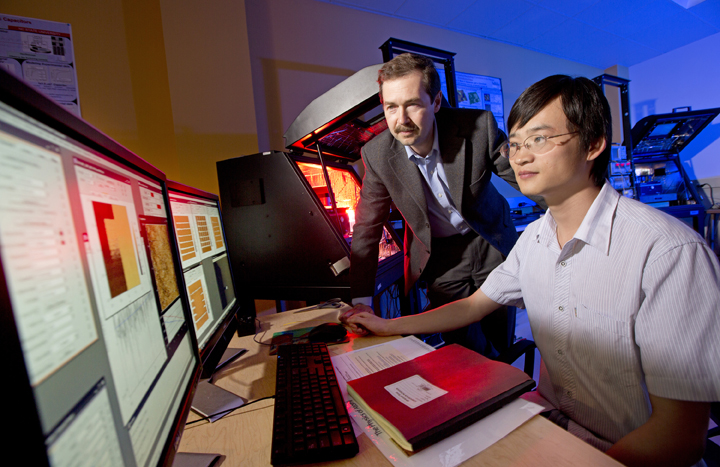
A team led by UNL physicist Alexei Gruverman in collaboration with researchers in Spain and at the University of Wisconsin has discovered a significantly more efficient method of data storage that offers great promise for the future of technology.
Gruverman’s research on electronic materials is done at the nanoscale, where objects exhibit unexpected chemical and physical properties. One nanometer is equal to one billionth of a meter. Central to his research is the scanning probe microscopy technique which is based on exerting highly localized mechanical, electrical or magnetic influence on an object by using a tiny physical probe and measuring the object's response. The technique works much like a person's sense of touch, Gruverman said.
"If you are in a dark room and want to find out whether the surface of this desk is smooth or rough, solid or soft what do you do?" he said, pointing to his desktop. "You touch it with your finger, press a bit and scan with your finger and feel the response."
Similarly, the tip of the probe -- whose radius measures about 10 nanometers and is too tiny to be seen by the naked eye -- can scan a surface and offer researchers feedback. The probe also can be used to electrically change the local properties of ferroelectric materials, which are important electronic materials used in memory devices. The change that occurs is similar to what happens when magnetic materials are remagnetized by a magnetic field. By applying an electric potential to the probe, a nanoscale-size bit of electrical information can be stored in the ferroelectric material. This principle is central to data storage, like in hard disk drives.
To date, researchers have relied on the electrical voltage to store information. However, Gruverman's team found that the same bit could be written simply by pressing harder against the ferroelectric material's surface. In a sense and in this case, the probe's needle works much like a nanoscopic typewriter in its ability to write data in a very specific area on a ferroelectric film and leave data behind without damaging the surface. That finding makes the research team the first to demonstrate that mechanical force can be used to change an area’s polarization.
"It's a completely voltage-free switching of polarization, which is what makes the results of this research unique," Gruverman said.
The finding is groundbreaking because it opens up a new way to store data significantly more densely than has previously been available.
While Gruverman is hesitant to say such a finding could pave the way to a new generation of data storage devices like computers and cell phones, whose production ultimately is at the mercy of many other factors, it does establish the scientific basis that makes it possible, he said.
The team's findings were published April 5 in the journal Science, and includes Gruverman's graduate student, Haidong Lu, as a lead author. Other collaborators included a group of Spanish researchers led by Gustau Catalan and the team led by Chang-Beom Eom from the University of Wisconsin.
At the time of their discovery, Gruverman and other UNL researchers were engaged in a separate study supported in part by the U.S. Department of Energy, Office of Basic Energy Sciences, Division of Materials Sciences and Engineering. Related research also receives funding from UNL's Materials Research Science and Engineering Center, which is part of a nationwide network funded by the National Science Foundation that's designed to support interdisciplinary and multidisciplinary materials research and education of the highest quality while addressing fundamental problems in science and engineering that are important to society.
Gruverman said his team hopes to build on this discovery by investigating other possible applications.
- Jean Ortiz Jones